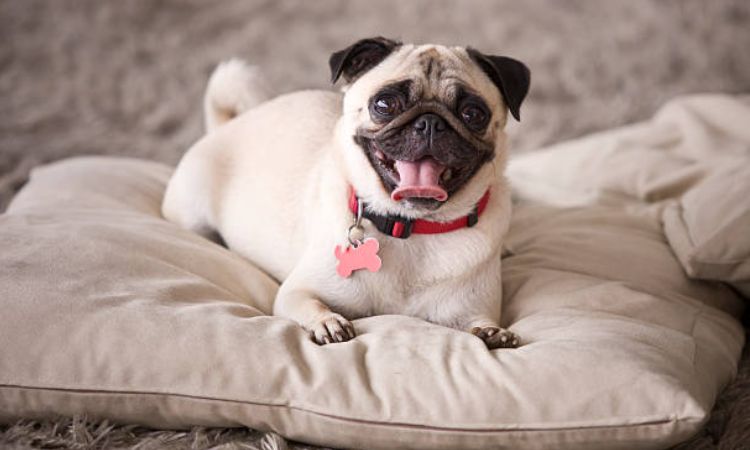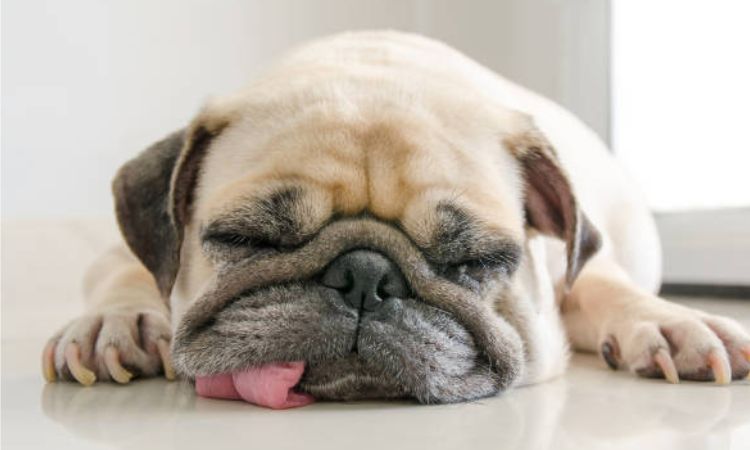Pugs may be small in size, but when it comes to shedding, they can leave a surprisingly big trail of fur behind. If you’ve ever found yourself lint-rolling your clothes for the third time in a day or wondering whether your pug’s fluff explosion is normal, you’re not alone.
Today, Nexus-Pets dives into the truth about pug shedding—why it happens, how much is too much, and the expert tips you need to keep your home (and wardrobe) as fur-free as possible.

Is Pug Shedding Normal?
Shedding is a completely normal part of a pug’s life cycle. Pugs are known as moderate-to-heavy shedders, and unlike some breeds that shed only seasonally, they typically shed year-round. However, shedding can increase significantly during seasonal coat changes in spring and autumn, when old hair is replaced with new growth to adapt to temperature changes.
The amount of shedding can also vary depending on a pug’s age and coat color. For example, fawn pugs with double coats often shed more heavily than black pugs, which usually have a single coat. Senior pugs may experience lighter or patchier shedding due to reduced hair density, while young adults in peak coat condition tend to shed more consistently.
Certain triggers can temporarily increase shedding, including baths (which loosen dead hair), heat cycles in female pugs, and hormonal changes such as pregnancy or recovery from illness. While these fluctuations are usually normal, excessive or sudden hair loss accompanied by skin irritation may indicate an underlying health issue that requires veterinary attention.
Factors Affecting Pug Shedding
Several key factors influence how much a Pug sheds, and understanding them can help you manage it more effectively:
- Coat type – Most fawn, silver-fawn, and apricot-fawn Pugs (and some black Pugs) have a dense double coat, which sheds heavily. Many black Pugs have a single coat that typically sheds less, though exceptions exist.
- Season and daylight changes – Pugs shed all year round, but shedding often increases in spring and autumn. Seasonal coat changes are triggered not only by temperature shifts but also by changes in daylight hours, signaling the body to grow or shed the undercoat.
- Age – Puppies shed relatively little, but once a Pug reaches 12–18 months, shedding levels increase and remain consistent into adulthood.
- Health factors – Allergies, poor diet, stress, and skin conditions can all increase shedding. Addressing these issues can help improve coat health and reduce excess hair loss.
- Bathing frequency and grooming habits – Bathing can temporarily trigger shedding by loosening dead hairs, but regular brushing and proper grooming afterward help control fur loss and maintain a healthy coat.
And Female heat cycles Unspayed females often experience significant shedding toward the end of their heat cycle due to hormonal fluctuations.

Signs of Excessive or Abnormal Shedding
While shedding is a natural and expected part of owning a Pug, there are certain signs that indicate your dog may be experiencing abnormal or excessive hair loss, which could be a symptom of an underlying health issue.
Patchy Fur or Bald Spots
One of the most obvious signs of abnormal shedding is the appearance of patchy areas where fur is thinning or completely missing. Unlike normal shedding, which usually results in loose hair scattered around the home, excessive shedding may cause noticeable bald spots or uneven fur coverage on your Pug’s body.
Accompanying Symptoms: Itching, Skin Irritation, and Redness
Excessive shedding is often accompanied by other symptoms such as persistent itching, redness, inflammation, or irritated skin. These signs can indicate allergies, parasitic infections (like fleas or mites), skin infections, or other dermatological conditions. If your Pug is frequently scratching, licking, or biting certain areas, this should raise concern.
When to Consult a Veterinarian
If you observe any of the above signs—especially bald patches combined with discomfort or skin abnormalities—it is important to seek veterinary advice promptly. A professional can diagnose underlying causes such as allergies, hormonal imbalances, infections, or other medical conditions like mange or alopecia. Early diagnosis and treatment can help manage shedding issues effectively and improve your Pug’s overall health and comfort.
Expert Tips to Manage and Reduce Shedding
Managing shedding in Pugs requires a consistent grooming routine combined with proper care and nutrition. Here are expert recommendations to help you keep your Pug’s shedding under control and maintain a healthy, comfortable coat.
Regular Brushing
To minimize loose hairs and prevent them from spreading throughout your home, it’s important to brush your Pug regularly. Ideally, brushing should be done at least three times a week, though some Pugs with heavier shedding may benefit from daily sessions. Use tools designed specifically for dense, double coats to reach deep beneath the top layer of fur. Starting with a de-shedding tool or grooming mitt helps pull out dead hairs effectively, followed by a soft bristle brush to smooth and shine the coat.
Best Grooming Tools
Tools with stainless steel teeth or rubber tips are highly effective for Pugs. Stainless steel de-shedding brushes can reach deep into thick fur without damaging the topcoat, making them ideal for fawn or double-coated Pugs. Grooming gloves or mitts with rubber nubs provide a gentle yet thorough removal of loose hairs and are often enjoyed by dogs as they simulate a massage.
Bathing Advice
Bathing your Pug about once a month helps remove loose hair and refreshes the skin and coat. Use dog-friendly shampoos formulated for shedding control and sensitive skin to avoid irritation. After bathing, it’s crucial to dry your Pug thoroughly—either by towel drying or using a low-heat blow dryer—especially in skin folds and tail pockets to prevent moisture-related infections.

Nutritional Supplements
A balanced diet plays a key role in maintaining a healthy coat. Supplements rich in omega-3 fatty acids, specifically EPA (eicosapentaenoic acid) and DHA (docosahexaenoic acid) derived from fish oil, can strengthen fur, reduce breakage, and support skin health. These supplements can help reduce excessive shedding and improve your Pug’s overall coat condition. Always consult your veterinarian before starting any supplements.
Pugs’ distinctive facial folds and wrinkles require regular cleaning to prevent bacterial or yeast infections, which can exacerbate skin irritation and shedding. Use gentle, dog-safe wipes or cleansers to keep these areas clean and dry.
Additional Care – Nail Trimming and Dental Hygiene
Maintaining your Pug’s nails and dental health also contributes to their overall well-being. Regular nail trimming prevents discomfort or injury during grooming sessions, while dental hygiene supports general health. Including tooth brushing in your Pug’s grooming routine can prevent oral diseases that indirectly affect their comfort and stress levels, potentially influencing shedding.
Hopefully, these tips help you manage your pug’s fur and keep your home a little cleaner. Remember, some shedding is completely normal for pugs, but with a consistent grooming routine, you can keep it under control.






